
School Leaver CV examples + guide

Build your CV on this template

You’re leaving school and you need to write a CV to land your first job… Exciting times!
But you probably have no idea how to write a CV, or perhaps you aren’t even sure what a CV is.
But don’t worry…
I’ve created this mega guide to writing a school leaver CV, which includes 4 school leaver CV examples and a step-by-step guide to writing your own.
So, you can create a winning CV that will attract employers and get you plenty of interviews, even if you have no work experience.
School leaver CV example

Build your CV now
School leaver CV (with no experience)
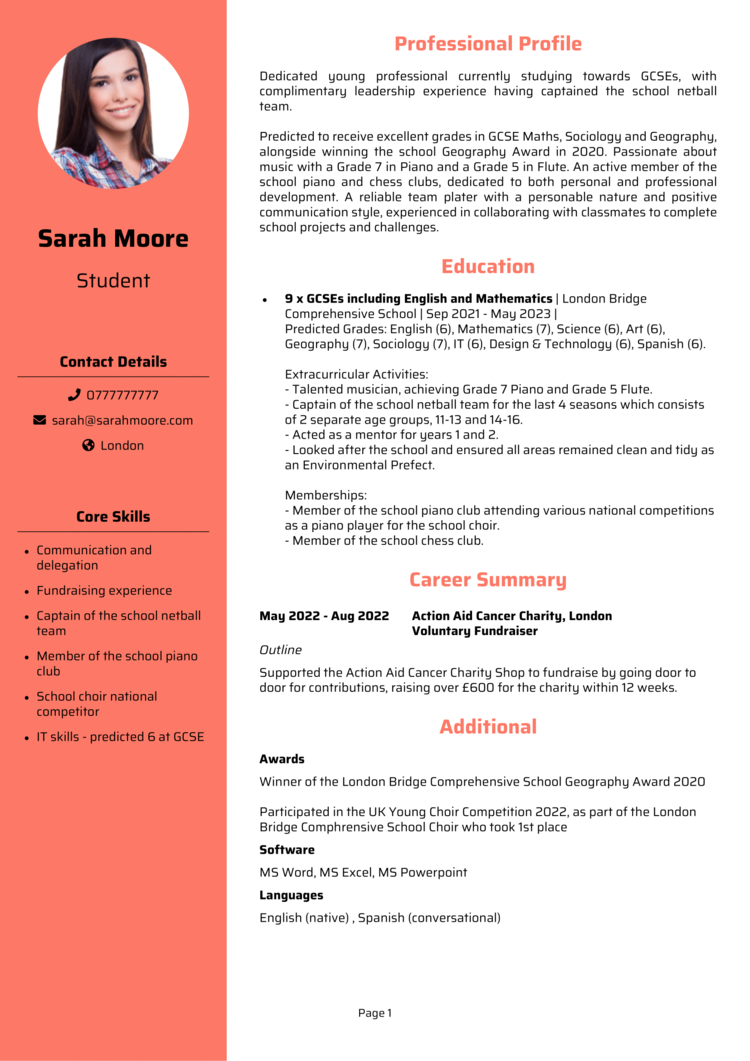
CV templates
School leaver CV (with part time experience)
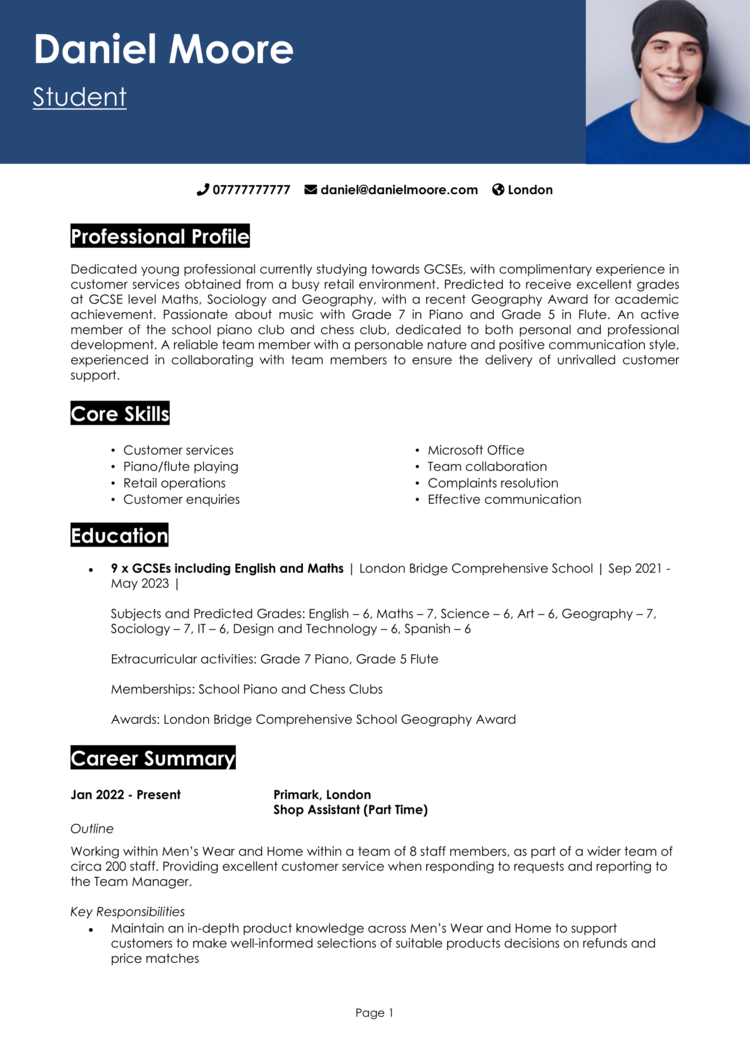
College leaver CV
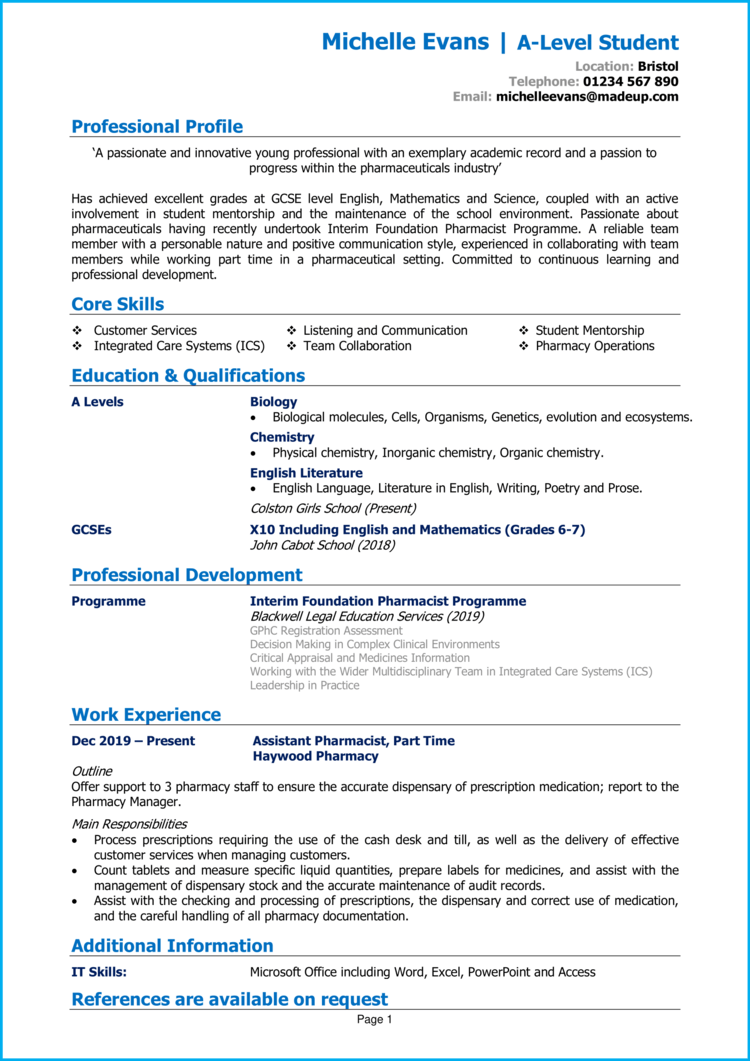
What is the purpose of your CV?
The ultimate purpose of your CV is to secure job interviews for you.
Think of it as a leaflet for your services; advertising your skills and knowledge to potential employers.
You create your CV and promote it out in the job market to get noticed by firms you want to work for.
If an employer likes your CV, they will call you and invite you in for an interview
So as you can imagine, it needs to look professional and read extremely well if it’s going to be effective.
Who will read your CV?
Your CV will mainly be read by hiring managers and recruiters .

When you apply for a job online, recruiters will review your CV to find out if you have the requirements they are looking for to fill their vacancy
If your CV makes a good impression, then the recruiter will call you with a view to book you in for an interview, or pass your CV on to the hiring manager.
Recruiters and managers tend to be very busy and often have to review hundreds of CVs every week – so your CV needs to grab their attention and explain your value quickly.
What makes a good school leaver CV?
What makes a good CV?
A good CV is one that quickly shows recruiters and managers that you have all the necessary skills and knowledge required to perform their vacant role – it’s that simple, and it shouldn’t be over complicated.
If your CV can do this, you will generate lots of interest and interview requests from employers.
It needs to be clearly structured and formatted – and the content should explain to readers why you are a good candidate for the job being advertised.
What if you have no work experience?
Don’t worry too much about having little or no work experience.
We all have to start somewhere and plenty of students are able to find jobs straight from school at 16 years old , without experience or contacts.
You just have to be a little more creative when writing your CV and draw transferable skills out from things like school/university projects, qualifications, hobbies, extracurricular activities , volunteer work and part-time work.
Using a blend of structure , formatting , language and content, anyone can write an attractive CV.
I will cover how to do this in more detail, in the “ How to write a school leaver CV ” section
What should you put in your CV?
When you are new to the world of work, it can be difficult to know what information you should include in your CV.
So before you start writing your CV, it’s wise to do some research and find out exactly what your target employers are looking for in a candidate.
So head over to a job website and run a search for the type of job you are looking for
You can use a site like CV Library (it will open in a separate window)
Then look through 10 or more job adverts and make a list of the most important candidate requirements that keep appearing.
Requirements will include things like:
- Qualifications – GCSE’s, A-levels, Degrees etc.
- Soft skills – Communication, leadership, organisation etc.
- Hard skills – Literacy, numeracy, languages etc.
- IT capabilities – Outlook, Word, PowerPoint, Photoshop etc.
- Industry knowledge/experience – Accountancy, marketing, design etc.
- Extra-curricular activities – Sports, hobbies, personal projects etc.

Now that you have an extensive list of the things that your target employers are looking for, you know exactly what you should be highlighting in your CV.
You probably won’t possess all of the requirements, but you should always refer to this list when writing your CV, and try to demonstrate as many as you can.
Quick Tip: In some cases where you don’t have a particular requirement, it can be beneficial to show that you are working towards it. For example if a job advert is asking for basic HTML knowledge and you don’t have it – start taking an online course on the subject and include it in your CV.
How to write a school leaver CV
Now that you have seen some example CVs, here’s how to write your own interview-winning school leaver CV.
CV structure and format
Start of by working to the following structure:
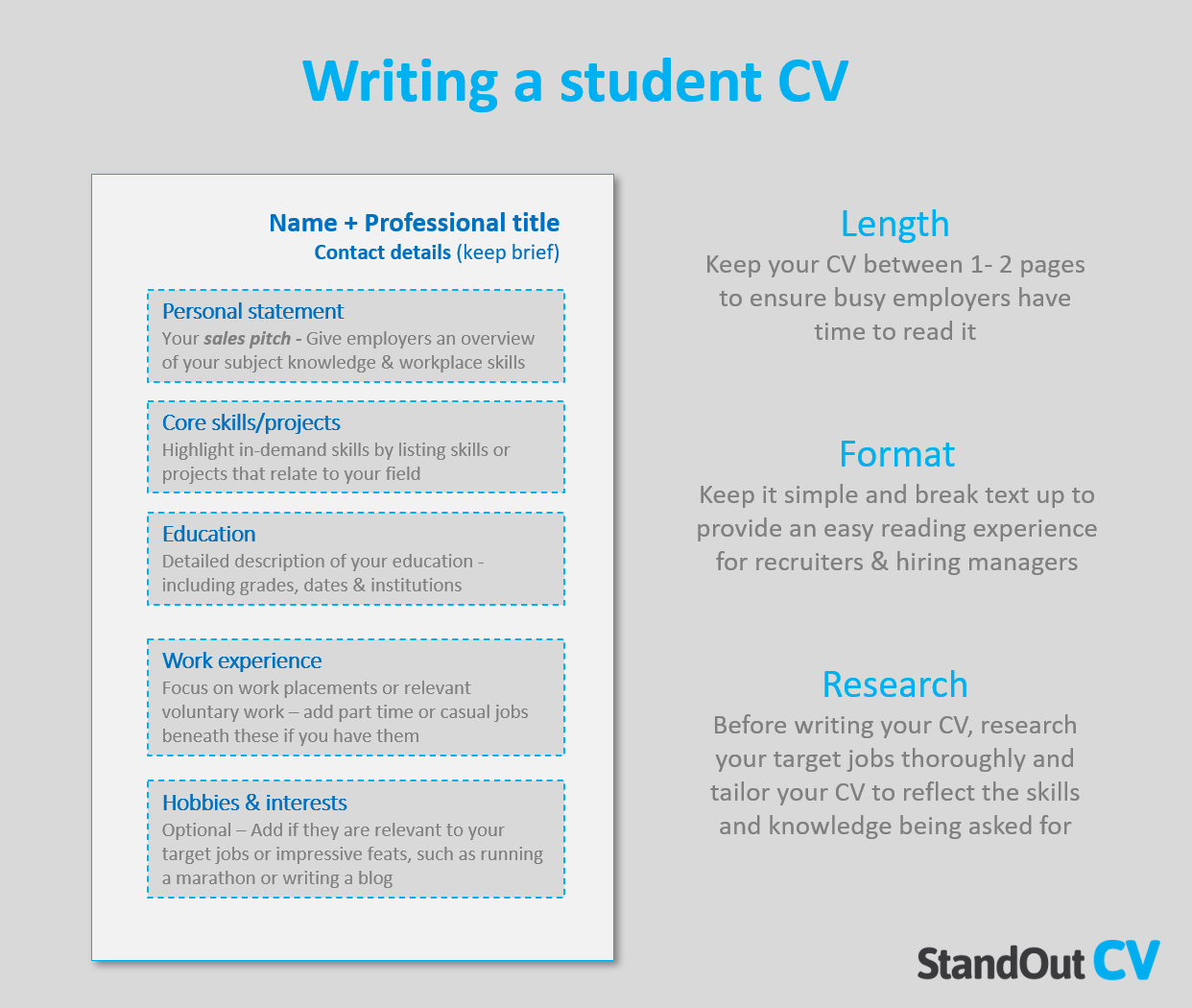
CV formatting tips
- Use a simple clear font – Ensure that employers can read your CV without any confusion
- The colour scheme should be plain with black text on a white background creating the easiest reading experience.
- Text should be broken up as much as possible to ensure that busy recruiters and hiring managers can digest the information quickly
- Use big bold headings to clearly define sections and break the information up further
Name, title and contact details
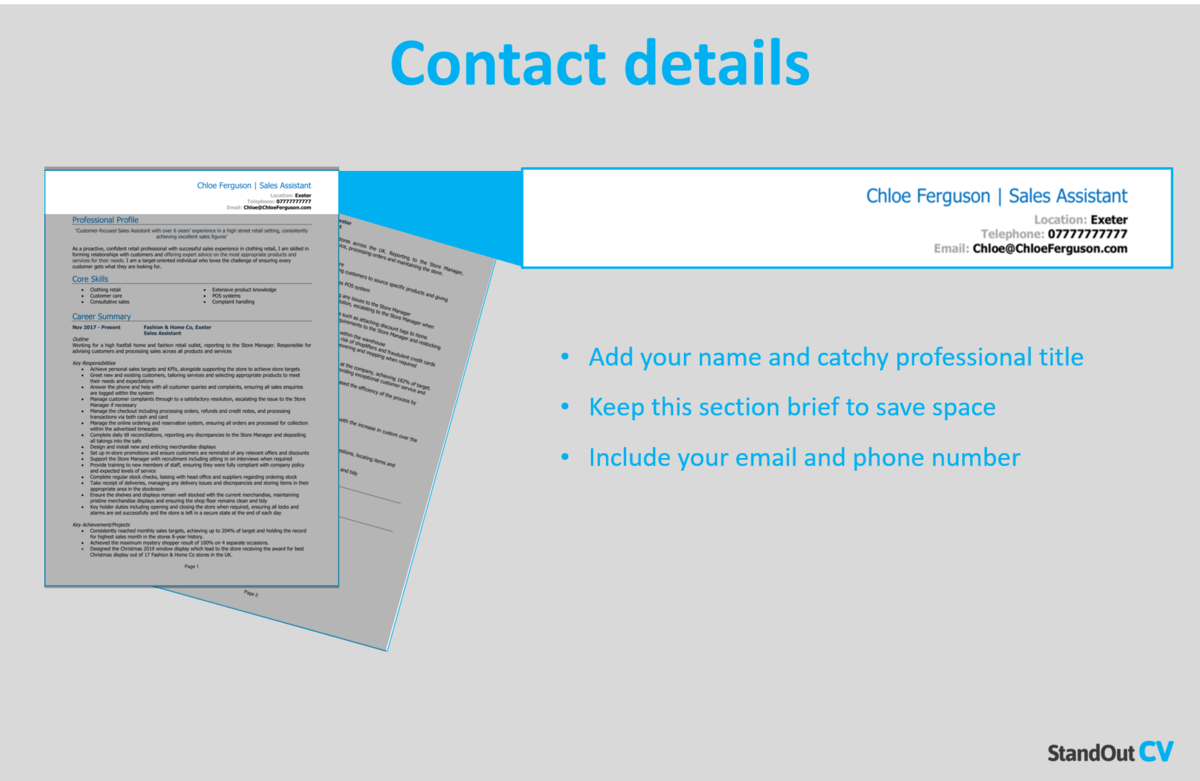
Head your CV up with you name in bold and a professional title that relates to your field.
Put your contact details just underneath your name so that it’s easy for recruiters to get in touch with you.
- Phone number
- Email address
- Location (no need to put your full address – general area where you live or are willing to work is fine)
- Link to LinkedIn profile (optional if you have a one and it’s good enough to share)
Take up as little space as possible with your contact details to save room on your CV.
If you have no work experience; check out my video guide to writing a CV when you have no experience
CV Profile/Personal Statement
Your CV profile or personal statement is your opening pitch to recruiters and employers.
It will be the first thing they read upon opening your CV, so you need to give them some good reasons to be interested in you.
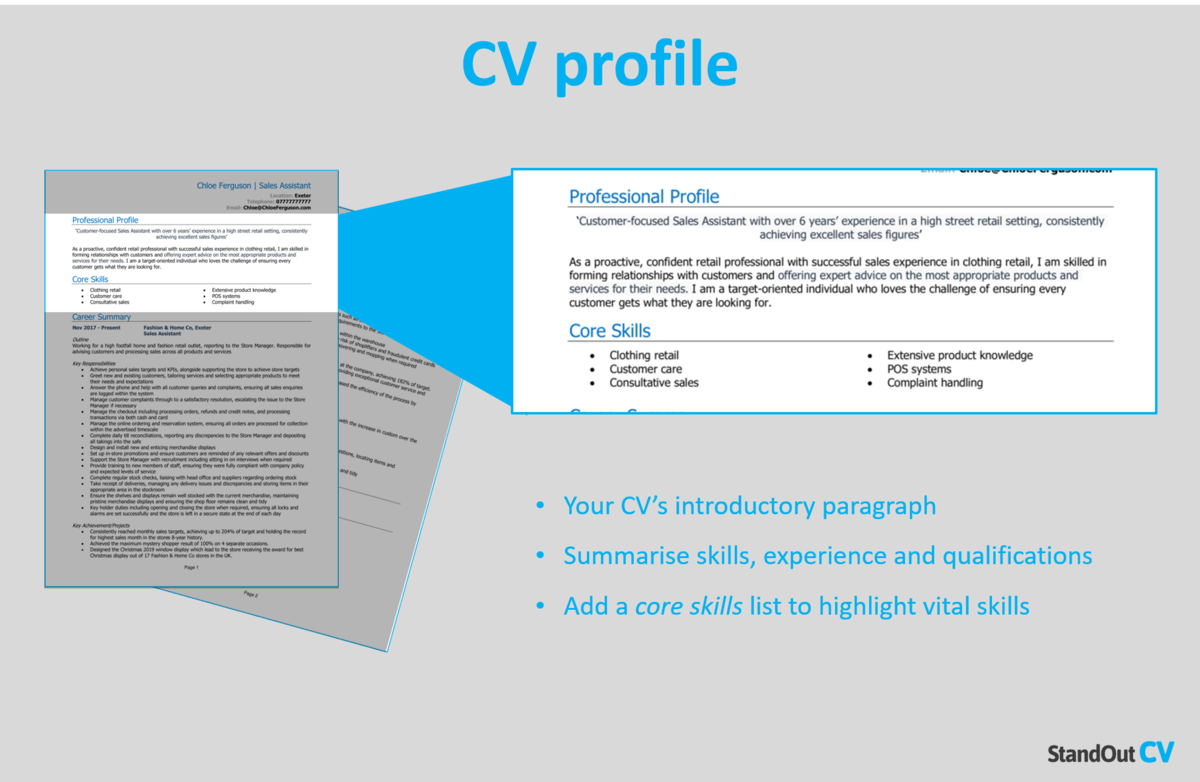
Ideally, you want to summarise the skills you have to offer an employer, in a way which reflects the qualities that they are looking for in a candidate – so again you should be referring to the list you made earlier.
Good things to include are;
- Your highest academic achievements – A Level in maths, 10 GCSEs A-C
- IT Package proficiency – Word, Excel, Photoshop
- Any experience that could be relevant to your target roles – School projects, voluntary work, work placements, personal projects or pursuits
- Relevant hard skills – Languages, literacy, numeracy
- Relevant soft skills – Communication, motivation, teamwork, personal skills
Take a look at the example CV profile below
This person is a school leaver with A-levels who is applying for office based sales roles .
They have no office based sales work experience .

However, they do have some part time supermarket cashier experience which involves some of the same skills and experience. So they have really taken advantage of that.
The trick is to write for the job you want , not the job you have. Really sell yourself to the reader.
Many school leavers think that their part time jobs in bars and retail stores bear no relevance to the jobs they apply for when they start working full time.
However there a lot of transferable skills that you can include in your CV, and by using the right language, you can create a very professional image with them – like the above.
Quick tip: A poorly written CV will fail to impress recruiters and employers. Use our quick-and-easy CV Builder to create a winning CV in minutes with professional templates and pre-written content for every industry.
Core skills & achievements
In order to give recruiters a very quick glimpse of your skills, use a bullet pointed core skills and achievements section.
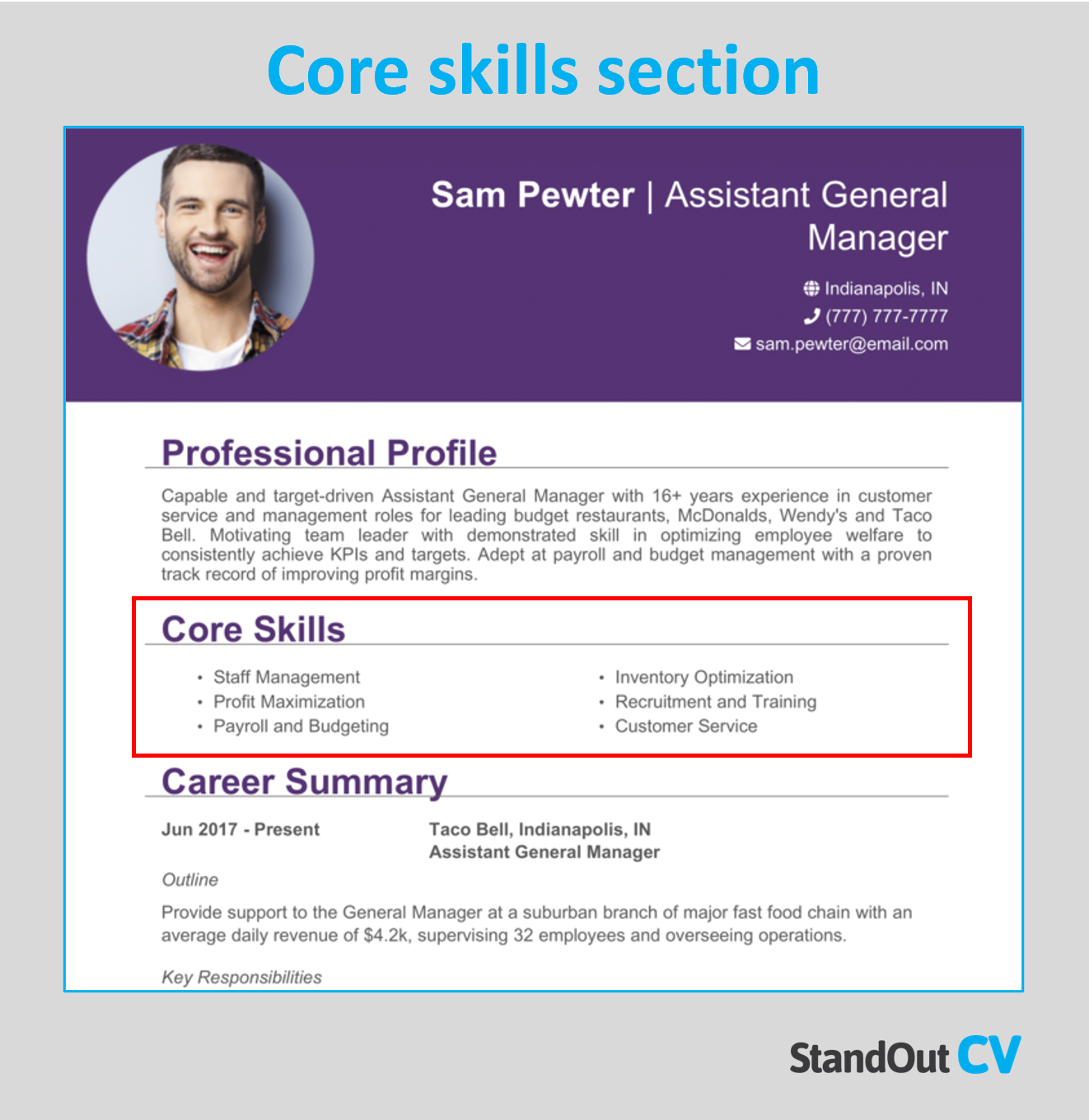
As I mentioned earlier, recruiters and managers tend to be very busy – so a bullet pointed list of valuable skills and achievements can give them a really quick snapshot of your talents, and encourage them to read the rest of your CV in full.
If you have carried out some notable projects that relate to your target roles, then it would be worth setting up a section underneath your core skills to list them like in the example school leaver CV above – but don’t worry too much if you haven’t.
If like most school leavers, you do not have any direct work experience in the field you are applying to, I would recommend listing your education next.
Start with your most recent qualification and work backwards to your earliest.
Include plenty of detail to compensate for your lack of work experience – especially if your education can be related to the jobs you are applying for.
However, if you do have some relevant work experience, then place your work history above your education.
Work experience
Work history is an area that many school leavers struggle with as they often work part-time jobs that they feel will not look impressive on their CV.
However, your work experience (no matter how unimportant you think it may be) gives you a great opportunity to demonstrate a lot of important skills that are required for nearly all jobs.
Things like:
- Communication
- Working with customers
- Organisation
They also give you an opportunity to show off your written language skills.
The below is a role description for a part time job working at a cafe –

Basic CV template
Start with the dates, company and role title.
Quick Tip: you can tweak the role title to sound as professional as you like. E.g. don’t write “Shelf Stacker” – instead go with something like “Shop Floor Operative” or “Sales Assistant” so that you appear as professional as possible.
Then provide an outline of the role that summarises the role and company as well as showing where you sit within the organisation’s hierarchy.
Then bullet-point your responsibilities in a way that demonstrates your valuable workplace skills.
Where possible try to show how your actions contribute to the success of the employer.
For example, instead of simply saying:
“Monitoring and replenishing stock levels”
Expand on that point and say:
“Monitoring and replenishing stock levels to ensure customers have access to all products and more stock is sold throughout the week”
This shows how important you are to the running of the business and how valuable you could be to an employer.
Hobbies and interests
When you lack work experience, your hobbies can be a great way to demonstrate some more of your talents.
Good hobbies to list are:
Work related interests – For example, if you are an aspiring web designer and have created a website in your spare time, then provide a link to the site – Or if you are applying for science related jobs and carry out your own research in your spare time, then tell readers about it.
Big achievements – Perhaps you’ve run a marathon, played for the school football team or competed in national chess competition – these types of activities show motivation and determination, so get them onto your CV.
Charitable work – Any kind of fund raising or volunteer work you undertake for charitable causes look great on your CV because they show you are willing to help others and often involve lots of organisation and planning.
Don’t list common hobbies like “ watching TV ” or “hanging out with friends” as they are unlikely to impress employers.
Writing a school leaver CV – Conclusion
Using the above advice you should be able to create an effective school leaver CV that will make a big impression on recruiters and ensure that you get invited to plenty of interviews.
Remember to keep the format easy-to-read and always tailor the content to match the demands of the employers you are applying to.
Also, check out our graduate CV and example customer service CV and writing guide.
More Junior CV examples
- Air Cadet CV
- Assistant Project Manager CV
- CV for University Application
- CV template for 15 year old +
- CV template for 16 year old +
- CV template for teenager
- Deck Cadet CV
- First CV templates – Write a winning CV for your first job
- Junior Architect CV
- Junior Software Developer CV
- Marketing Placement CV
- Masters Degree Application CV
- MBA Application CV
- Scholarship CV
- Trainee accountant CV
- Trainee Estate Agent CV
- Trainee Recruitment Consultant CV
- Trainee Solicitor CV
- Trainee Teacher CV

View Premium CV Package
3 High School Student CV Examples & Templates (+How-To Guide)
Posted by CV Nation on Apr 23, 2021
The ultimate guide to writing a perfect CV for high school students, which includes 3 high school CV samples and templates that you can get now.
Many high school students consider their lack of hands-on work experience to be problematic when it comes to writing their CV.
However, a lack of work experience doesn’t need to be a disadvantage for high school students.
In this guide, we’ll show you how high school students can prepare very effective CVs that use their education, school experiences and extra-curricular activities to present them as the perfect candidates for jobs.
Whether you’ve just left school and you’re pursuing your first job or you’re a high school student looking for a part time work, the guidance and CV templates in this guide will help you achieve your goals.
This guide covers all aspects of CV writing for high school students, including students with no work experience.
High School Student CV Example
How to Write a High School Student CV
Name, location and contact details.
Write your name at the top of your CV and include your location and contact details.
It is not necessary to include your full address. Simply list the town/city you live in and your country of residence.
Ensure to include your email address, phone number and a link to your LinkedIn profile if you have one.
Personal Statement/Professional Profile
After listing your name, location and contact details, it’s time to prepare your CV’s personal statement.
Personal statements, which are also referred to as professional profiles and CV summaries, are short, concise introductions at the beginning of your CV.
The goal of your CV’s personal statement is to provide an outline of you as a candidate and convey your skills and experiences to recruiters.
As a high school student and school leaver, your CV’s personal statement should ideally be focused on the skills you’ve obtained during your time at school, your work experiences (including voluntary work and non-paid work) and your ambitions.
Here is an example of a high school student’s CV personal statement:
Dependable, enthusiastic high school student with a strong work ethic and a track record of meeting challenging deadlines. Strong communicator, who is comfortable engaging with people from all backgrounds and delivering presentations to audiences.
Adept at effectively managing heavy workloads, with experience juggling heavy academic schedules with revision and extra-curricular activities. Passionate about professional development and is always eager to undertake training to obtain new skills.
If you have little or no work experience, which is the case for many high school students, consider opting for a skills-based CV.
Skills-based CVs enable students to make their skills and experiences gained at school the central focus of their CV. This style of CV is often much more effective for students as they simply don’t have enough work experience to sell themselves using the traditional CV format.
Take a look at the skills-based high school student CV template earlier in this guide. Note how, although the student has no work experience, the CV illustrates how she can add value to employers.
Of course, you don’t have to use a skills-based CV.
If you would prefer to opt for a traditional, reverse-chronological CV – like the other student CV templates in this guide – simply include a concise key skills section that highlights 9 or 10 of your strongest skills.
Which Skills are Most Important for High School Students?
When employers recruit students and entry-level employees, there are a number of key skills that many tend to prioritise.
Here, we list the 5 most sought-after skills for high school students and explain how to demonstrate them on your CV.
1. Time Management
Time management is one of the most in-demand skills for students and those looking to land their first job.
Employees with good time management are able to prioritise tasks, effectively manage schedules and meet targets. Those who don’t manage their time well may fail to meet targets and spend time procrastinating.
How do you show your time management skills on your student CV?
If you’re using a skills-based CV, use the skills section to provide concrete examples of times you have effectively managed your time. For example, while studying at school, did you create a revision schedule to help you allocate your time to all subjects equally?
If you’re not using a skills-based CV, use the work experience section to provide similar examples of your time management in the workplace.
By providing real examples such as this one, you’ll show recruiters that you’re adept at managing your time to achieve positive results.
2. Problem Solving
Recruiters are always on the look out for candidates with strong problem solving skills.
Problem solving is one of the most sought-after skills because it is pertinent to almost all jobs and tasks. Employees with good problem solving skills can think on their feet and react positively when things go wrong.
Sound problem solving skills also indicate that you possess a range of other key skills, such as creativity, analytical acumen and lateral thinking.
How do you show your problem solving skills on your student CV?
The best way to demonstrate your problem solving skills is to provide examples of your achievements that resulted from your problem solving skills.
If you have no work experience, think about problems you solved at school? For example, this may include solving problems with projects you worked on.
Highlight such achievements in your CV’s skills section, education section or work experience section.
3. Communication
Communication is an important skill for high school students and school leavers as it enables them to work effectively with colleagues. Employees with good communication skills can also follow instructions correctly and ask the right questions.
Good communication underpins many other valuable skills, such as leadership and relationship building, so it’s important to draw attention to your communication skills on your student CV (if you have good communication skills, of course).
How do you show your communication skills on your student CV?
During your time in school, you have likely participated in projects, events or activities that required you to communicate effectively. These are the types of activities that you should showcase on your CV to highlight your communication acumen.
For example, this may include delivering presentations as part of your coursework or taking part in drama performances.
Use your CV’s skills and education section to describe times you’ve demonstrated sound communication skills.
4. Enthusiasm
Employers want to recruit people who are enthusiastic about their work.
Enthusiasm is transmissible in the workplace and it helps to build positive environments in which employees flourish. Those who are enthusiastic about their job are also more likely to be open to learning new skills and taking on additional tasks.
How do you show your enthusiasm on your student CV?
While the cover letter is the best place to describe your enthusiasm for the job you’re applying for, you can demonstrate enthusiasm for learning and performing to high standards on your CV.
Highlight your commitment to learning and professional growth in your CV’s personal statement. Additionally, if you’ve obtained any work experience, show how your enthusiasm for your work helped you achieve results.

5. Organisation
When you leave school and start your first job, you’ll need to be well-organised in order to manage your workload. Good organisation helps employees meet deadlines, save time and complete tasks to higher standards.
How do you show your organisation skills on your student CV?
You don’t need to have work experience to demonstrate your organisation skills. School work and extra-curricular activities also require a high degree of organisation, so show how you utilised your organisation skills to excel in these areas.
For example, have you used specific software to help you manage your revision schedule? Or have you organised activities for a local sports club?
By drawing attention to these types of experiences, you’ll show recruiters that you can be a highly organised team member when you start your first job.
In this section, list your education details. As a high school student, this will most likely be your A Levels or your GCSEs.
If you are progressing towards your GCSEs or A Levels but haven’t yet sat your exams, include your predicated grades.
Consider using your CV’s education section to highlight key projects and activities that you’ve taken part in. For those with little or no work experience, this can help to illustrate your skills.
For example, if you’ve captained the school’s football team, you may want to highlight this to demonstrate your leadership skills.
Additionally, if you’ve studies subjects that are relevant to the job you’re applying for, include a list of topics/modules that you’ve undertaken. For example, if you’re applying for a job related to IT, include a list of the topics you’ve covered during your IT studies.
How should you format your education on your student CV?
Start by writing the name of the qualification, such as GCSE, followed by your grades, the name of the high school and the dates of study. Then, if relevant, list any modules and key projects/activities you’ve been involved in.
Here is an example of a high school student CV’s education section:
Work Experience
As a high school student, you may not have much, or any, work experience. If you do, include your work experience in this section.
View StudentJob's useful article on how to gain work experience as a student .
Use the reverse-chronological format, starting with your current or most recent position and progressing backwards.
List your job title, the company name, the location of employment and the dates of employment. Then use bullet points to describe your duties and achievements.
If you don’t have any work experience, feel free to skip this section. However, you may want to consider including activities and non-paid work you’ve carried out if it’s relevant.
For example, if you’re applying for jobs in IT and you’ve spent some time helping friends with IT projects, drawing attention to this would illustrate your relevant skills. However, you should state that this was not paid work.
Should You Include Your School Work Experience Placements on Your CV?
While your high school work experience placements may have only lasted one week, they can add a great deal of value to your CV, especially if you have no other work experience.
For many high school students, their only hands-on experience is there work experience placements. For others, it may be their only hands-on experience in the field they want to commence a career in.
So, it’s often highly beneficial to include work experience placements on your CV.
If possible, focus on the skills you developed during your work placement, as well as your accomplishments and duties.
Voluntary Work Experience
Have you undertaken any voluntary work? If so, include it in this section. Including voluntary work on your CV is a great way of bolstering it and impressing recruiters.
Format your voluntary experience in the same way you formatted your work experience. List your voluntary roles in reverse-chronological order, and use bullet points to highlight your duties and accomplishments.
Honours and Awards
Have you achieved awards or honours during your time in school? If so, list them in this section.
Including honours and awards is a great way of highlighting valuable skills and showing recruiters that you can add value.
How should you format honours and awards on your CV?
Include the name of the honour or award, followed by the name of the institution and the date you were presented with the honour/award.
Here is an example:
Young Leader Award, Example High School (2020)
If you only have a small number of honours and awards, you may not want to dedicate an entire section to them. If this is the case for you, simply list your honours and awards in your CV’s education section.
Additional Information
Finally, include any additional information in the final section of your CV.
This may include hobbies, interests, IT skills, language proficiency and licences.
High School CV Example
Further Tips for High School Student CVs
How long should high school student’s cvs be.
The optimal length for student CVs is between one and two pages.
If you have little or no work experience, one page will probably provide you with enough space to include all relevant sections. If you have a significant amount of work experience or voluntary experience, you may find that you need two pages.
One-page CVs are often more effective than longer CVs as they make for a better reading experience and the key information is easy to locate.
Check out our ultimate guide on how long a CV should be .
Fonts and Font Sizes
Which font and font size should you use when writing your high school student CV?
Select one of the modest, commonly used fonts, such as Calibri, Arial or Times New Roman. Steer clear of creative fonts; they look unprofessional and they’re often difficult to read when skim reading.
The best font size varies depending on the font you’re using and the amount of space you have to fill, but aim for a font size of between 10 pt. and 11.5 pt.
Should You Include a Photo on High School Student CVs?
CVs for job applications in the United Kingdom, United States, Canada, Australia and New Zealand usually should not have a photo.
However, CVs for jobs in continental Europe, including Spain and Germany, usually should have a photo.
For more information on this topic, check out our ultimate guide on whether you need to include a photo on your CV .
How Do You Optimise High School Student CVs for Applicant Tracking Systems (ATS)?
A significant number of recruiters and HR departments use Applicant Tracking Systems (ATS). ATS is a type of recruitment screening software that filters and ranks applicants’ CVs based on their suitability for the role. ATS determines candidates’ suitability based on specific keywords.
These keywords include essential skills and qualifications. A great way to discover the essential skills for jobs is to study the job description for the role you’re pursuing. This will give you an idea of the essential criteria for the job and the necessary keywords to include on your CV.
Formatting and layout also play a role in ATS compatibility. The high school student CV templates in this guide are optimised for ATS, so feel free to grab yours now.
Interested in learning how to write a graduate CV? Take a look at our three graduate CV templates and CV writing guide .
Or if you feel you could benefit from more comprehensive CV writing help, check out our ultimate guide on how to write a CV .
Share this post
← Older Post Newer Post →
Protect your data
This site uses cookies and related technologies for site operation, and analytics as described in our Privacy Policy . You may choose to consent to our use of these technologies, reject non-essential technologies, or further manage your preferences.
- CV and Cover Letter
- How to write a school leaver...
How to write a school leaver CV (with template & example)
8 min read · Updated on November 07, 2024

Thinking about stepping into the world of work?
As a student or school leaver, you're probably wondering how to write an impressive CV that will help you onto the career ladder. Don't fret – even if you have no previous work experience, you can write a CV that showcases your skill set. Read on to find out how to write a school leaver CV, what to include and exclude, along with a template and example to use as inspiration.
What is a school leaver CV?
A school leaver CV is a document that provides a brief account of your education, qualifications, and employment or volunteer experience. Whether you've completed year 11 with GCSEs, or college with a BTEC, GNVQ, A Levels, or Highers and Advanced Highers, you need a CV.
As a current student or recent school leaver, you may have limited professional experience. However, qualifications, skills, and voluntary work can be used on your CV to demonstrate your competencies when applying for your first job, apprenticeship, or internship.
What to include in a school leaver CV
The format of a CV is flexible. After all, every person and their experiences are unique, so the document structure must be malleable. However, there are essential elements to include in your CV that prospective employers expect to see and that you can leverage as a school leaver. They include:
Contact information (or CV header )
Personal statement
Competencies and skills
Work and voluntary experience
Hobbies and interests
How to write each section of your school leaver CV
Ready to put pen to paper? To help increase your chances of success in securing your first job, follow these steps to create your school leaver CV:
1. Contact information
Every CV starts with your contact information, not the title “CV” or “Curriculum Vitae.” The information to include is your full name, location, phone number, and email address. If you have a link to your LinkedIn profile , a website or a professional online portfolio , you can add that too.
2. Personal statement
Next on your CV is a personal statement, which is also known as a professional summary or personal statement. Note that this is not the same as a personal statement written as part of a university application.
Your personal profile is a short paragraph consisting of two or three sentences summarising who you are, your relevant qualifications or experience, and your job goals. For example, as a school leaver, you may write that you have recently completed school and are looking to take your first steps in a particular industry.
3. Competencies and skills
Following your personal statement is a section designed to highlight your most relevant competencies, skills, and achievements.
Use bullet points to list between six and nine of your most impressive abilities and achievements that are relevant to the role you're applying for. They could be hard skills from particular classes, such as IT, or soft skills you have cultivated throughout your education.
Top tip: Tailoring this CV section to each position, as it's often the first thing a hiring manager reads. If your points align with the role requirements and the potential employer's needs, you'll create a powerful first impression.
4. Education
Since you're a school leaver, your education is very important and is likely to be a stronger representation of your skill set than your work experience. This is especially true if you're applying for your first job. As a result, it should be the next section on your CV. Here's a quick breakdown of how you can optimise this section:
Use reverse chronological order: Detail your educational history from GCSE level onwards, working in reverse chronological order . For each institution, include the school name and bullet point the name of the qualifications you gained there, along with the grade. If you're awaiting results, you can add predicted grades and the expected date of completion.
Prioritise your highest qualifications: If you're attending college, summarise your GCSEs in one line as your college-level qualification is more advanced and therefore a more accurate representation of your current competency level. However, we would recommend mentioning Maths and English GCSE grades as they're often a prerequisite for many jobs. For example, “9 GCSEs including grade 6 in English and Maths.”
Add awards and memberships: If you've received academic awards, were a member of any clubs, or took part in extracurricular activities, you may choose to list them in this section too. Alternatively, you can list them in a dedicated awards section or your hobbies and interests section.
5. Work and volunteer experience
If you have some work or volunteer experience, no matter how brief, it could be a great addition to your CV. However, if you don't, you can skip this section.
Listing relevant work experience is very similar to your education section, whereby each experience is listed in reverse chronological order, detailing the company name, your job title, employment dates, a brief overview of your role to add context, and a bullet-point list of key achievements.
To ensure that your listed experience strikes a chord with the prospective employer, review the job description and identify key requirements and phrases that align with your own experience and be sure to reference them.
6. Relevant hobbies and interests
Include this section especially if you're writing a CV for a school leaver with no experience. While a hobbies and interests section is optional when writing a CV for a school leaver, it can be used to leverage your candidacy and show off your personality.
Hobbies and interests that relate to key requirements listed in the job description and showcase your work ethic would be a good addition to your school-leaver CV. For example, playing football would suggest you possess motivation and teamwork abilities and can work under pressure.
If you're not sure whether you should add a hobby or interest, always ask yourself, “Will adding this help me to get the job?” If the answer is no, it's okay to leave it out.
How to format a school leaver CV
By this point, you should feel ready to write your CV. Here are a few formatting tips and tricks and general guidelines when writing a school leaver CV:
Headings: Use clear headings for each section of your CV to make the document easily digestible.
Font type: Contemporary, simple font types are better as they create a modern and clean read.
Font size: Keep body text between 10 and 12 point font and headings between 14 and 18.
Length: Your CV should be two pages maximum . As a school leaver, it could easily be one page.
Spacing: Standard 1.15 spacing is your best option on a CV.
Margins: 2.5cm margins are standard, but you can decrease them to 1.5cm if you want to fit your CV nearly onto one or two pages.
File type: The best CV file type is a Word document, as it will maintain formatting and an ATS will be able to read it accurately.
Bonus: what not to include on a school leaver CV
There are a few details that you don't need to list on a school leaver CV. They include:
Referees: You don't need to add the line “references available upon request” at the end of your CV, as asking for references is standard recruitment practice and employers know you will have them available.
Headshot: You do not need to add a photo of yourself to your CV. While commonplace in other countries, it is not a requirement in the UK due to anti-discrimination legislation.
Protected characteristics: You do not need to include sensitive information, such as age, race, religion or belief, marital status, sexual orientation, sex or gender reassignment, or disabilities as they are protected characteristics under the Equality Act 2010 .
CV template for a school leaver or student

School leaver CV example
To help guide you, here's an example CV for a school leaver in the UK:

Ready to craft your CV?
Writing an interview-winning school leaver CV can be daunting, but it's definitely achievable. If you lack the professional experience, remember to lead with your hobbies and interests while weaving in the appropriate skills throughout your CV. Follow our step-by-step guide and use the provided template and example to guide you along the way.
To save you any doubts, submit your CV for a free review and our experts will tell you if you're on the right track to job search success.
This article was originally written by Laura Slingo and has been updated by Charlotte Grainger.
Recommended reading:
How to write a CV for a 16-year-old (with examples)
How to write a CV for a job with no experience
How to write a personal statement for a CV
Related Articles:
Understanding OTE: meaning, types & salary examples
Character reference: example, template & writing tips
Writing a Europass CV: how it differs from a standard CV
See how your CV stacks up.
Career Advice Newsletter
Our experts gather the best career & CV tips weekly. Delivered weekly, always free.
Thanks! Career advice is on its way.
Share this article:
Let's stay in touch.
Subscribe today to get job tips and career advice that will come in handy.
Your information is secure. Please read our privacy policy for more information.

IMAGES
VIDEO
COMMENTS
Write a winning school leaver CV with these 4 example school leaver CVs and writing guide. Learn how to create the perfect CV structure and fill it with compelling content, even if you have no experience.
If you're a recent school leaver, learning how to write a CV could help you earn an interview. In this article, we explain what a school leaver CV is, list the information you can include in one and provide steps, a template and an example to help you create your own CV.
Write a memorable school leaver personal statement. Your CV should begin with a personal statement, a 3–4 sentence paragraph outlining your major achievements and professional goals. As you’re just starting your career, your school-leaver personal statement helps the employer understand what motivates you and why you want the job.
As a high school student and school leaver, your CV’s personal statement should ideally be focused on the skills you’ve obtained during your time at school, your work experiences (including voluntary work and non-paid work) and your ambitions. Here is an example of a high school student’s CV personal statement:
Similar to a school leaver personal statement, but with extra attention paid to specific things you’ve studied during higher education. Once again, try and explain why you’re applying and where you’d like to go in your career, as well as the specific skills or knowledge you can offer.
2. Personal statement. Next on your CV is a personal statement, which is also known as a professional summary or personal statement. Note that this is not the same as a personal statement written as part of a university application.